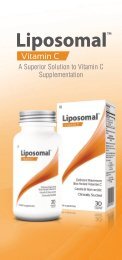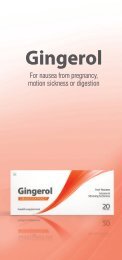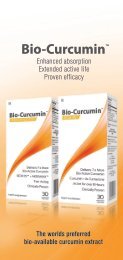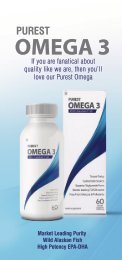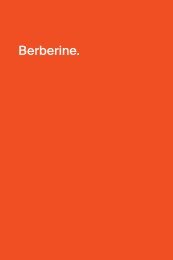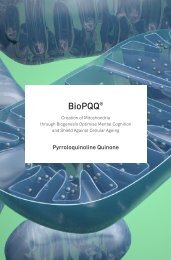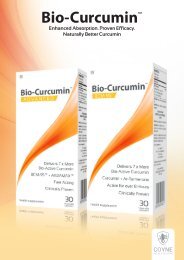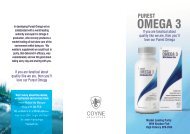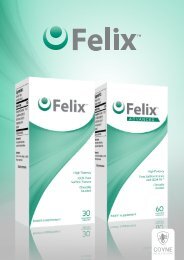FELIX Advanced
Create successful ePaper yourself
Turn your PDF publications into a flip-book with our unique Google optimized e-Paper software.
The Current State of Mental and Emotional<br />
Health in Society<br />
More people suffer from depression today than ever before. Reports from the Centers for Disease Control<br />
reveal that 1 in 10 US adults believe they are suffering from depression. In a press release for World Health<br />
Day on 7 April 2017, the WHO stated that depression is the leading cause of ill health and disability.<br />
Over the last 25 years, the use of antidepressant medication in the US has gone up 400%, and 11% of<br />
Americans aged 12 years and over now take antidepressant medication.<br />
Approximately 90% of patients on antidepressant medication experience at least one of the numerous<br />
serious side effects, which can include anxiety, constipation, thoughts of suicide, insomnia, and weight gain.<br />
A recent study reported on the association between the use of selective serotonin reuptake inhibitor (SSRI)<br />
antidepressants during pregnancy and the risk of autism and developmental delay in boys [Harrington<br />
RA, et al. Pediatrics 2014;133(5)]. One extremely common adverse effect that afflicts as many as 80%<br />
of individuals who take antidepressants is sexual dysfunction [Csoka A, et al. Journal of Sexual Medicine<br />
2007;5(1)].<br />
In fact, while antidepressants often lose their efficacy over the course of treatment, their sexual side effects<br />
can continue long after -—even years after—- drug use is discontinued.<br />
Saffron<br />
Saffron (Crocus sativus) is a plant, the dried stigmas (thread-like parts of the flower) of which are used<br />
to make saffron spice. It can take 75,000 saffron blossoms to produce a single pound of saffron spice.<br />
Saffron is largely cultivated and harvested by hand with the bulk of global supply coming from Spain<br />
and Iran. It is believed that Iran produces up to 90% of the world’s saffron. Due to the labour involved in<br />
harvesting, saffron is considered one of the world’s most expensive spices.<br />
Not only are the stigmas used for spice but they are also used in the production of medicine. Saffron has<br />
long been used in traditional medicine around the world, and modern scientific study is verifying that<br />
saffron has health benefits and disease fighting ability. It is believed that crocin, safranal and picrocrocin are<br />
the isolated compounds responsible for saffron’s therapeutic benefit. Saffron has been used in traditional<br />
medicine for suppressing cramps, treating respiratory disorders, coughs and colds, scarlet<br />
fever, smallpox, cancer, hypoxia, and asthma. Scientific evidence today shows<br />
its potential as an anticonvulsant, a free radical scavenger and antioxidant,<br />
a cytotoxic agent against cancer cells (in vitro), and<br />
increases the level of serotonin in the brain.<br />
Saffron has been prized since ancient Persian times as a<br />
way to enhance mood, relieve stress and as an aphrodisiac.<br />
Modern science, through clinical research and data, is now<br />
confirming saffron’s effective ability to enhance mood safely.<br />
This has led to the development of a standardized saffron<br />
extract, for therapeutic and measured use.
Felix utilises a clinically studied, high potency,<br />
proprietary extract of saffron. This exclusive extract<br />
provides:<br />
Proven efficacy.<br />
Standardized pharmaceutical quality.<br />
Safety.<br />
30mg of saffron extract per capsule.<br />
High potency delivering 3% crocin and 2%<br />
safranal.<br />
Felix provides an innovative solution which is:<br />
Scientifically and clinically based.<br />
Safe to use within the recommended daily<br />
intake.<br />
No known contra-indications.<br />
Can be used on its own or as an adjunct to<br />
other forms of treatment.<br />
Saffron has been shown to work directly on<br />
serotonin and dopamine.<br />
Balance Brain Chemistry with Saffron<br />
• Chemical antidepressant drugs are taken by 11% of Americans, 90% of whom suffer at least one of the<br />
numerous adverse effects that range from convulsions to abnormal bleeding to sexual dysfunction.<br />
• An increasing number of studies demonstrate that saffron treats depression with equal success but<br />
without risky side effects.<br />
• Research reveals that saffron also successfully treats other conditions for which antidepressant<br />
medications are used including anxiety, Alzheimer’s disease and obsessive-compulsive disorder.<br />
• Research evidence now shows that when saffron is added to the regimen of male and female patients<br />
already taking antidepressants, it reverses some of the sexual side effects associated with these drugs.
Study 1<br />
Comparison of Crocus sativus L. and imipramine in the treatment of mild to moderate depression: a pilot<br />
double-blind randomized trial.<br />
Akhondzadeh S, et al. BMC Complementary and Alternative Medicine 2004;4(12).<br />
Hamilton Depression Score<br />
22<br />
20<br />
18<br />
16<br />
14<br />
12<br />
10<br />
8<br />
6<br />
Background:<br />
ns<br />
ns<br />
0<br />
**<br />
***<br />
***<br />
***<br />
***<br />
***<br />
1 2 3 4 5 6 7<br />
Trial (week)<br />
*** ns ***<br />
ns<br />
***<br />
The objective was to compare the efficacy of stigmas of Crocus sativus (saffron) with imipramine in the<br />
treatment of mild to moderate depression in a 6-week pilot double-blind randomized trial.<br />
***<br />
Cap. Saffron<br />
Cap. Imipramine<br />
Mean ± SEM scores of two<br />
groups of patients on the<br />
Hamilton Depression Rating<br />
Scale. (ns) Non-significant; (**)<br />
P < 0.01 and (***) P < 0.001.<br />
The horizontal symbols (**<br />
and ***) were used to express<br />
statistical significance versus<br />
their respective baseline value<br />
and ns symbols are for between<br />
group comparisons.<br />
Methods:<br />
Thirty adult outpatients who met the Diagnostic and Statistical Manual of Mental Disorders, 4th edition for<br />
major depression based on the structured clinical interview for DSM IV participated in the trial. Patients had<br />
a baseline Hamilton Rating Scale for Depression score of at least 18. Patients were randomly assigned to<br />
receive saffron 30 mg/day (TDS) (Group 1) or imipramine 100 mg/day (TDS) (Group 2) for 6-weeks.<br />
Results:<br />
Both groups showed a significant improvement over the 6 weeks of treatment (P < 0.0001). The difference<br />
between the two protocols was not significant (F = 2.91, d.f. = 1, P = 0.09). Saffron at this dose was found to<br />
be as effective as imipramine in the treatment of mild to moderate depression. In the imipramine group<br />
anticholinergic effects such as dry mouth and sedation were observed more often than was predictable.<br />
Conclusion:<br />
The main overall finding from this study is that saffron may be of therapeutic benefit in the treatment of<br />
mild to moderate depression.
Study 2<br />
Hydro-alcoholic extract of Crocus sativus L. versus fluoxetine in the treatment of mild to moderate<br />
depression: a double-blind, randomized pilot trial.<br />
Noorbala AA, et al. Journal of Ethnopharmacology 2005;97(2).<br />
Hamilton Depression Score<br />
26<br />
24<br />
22<br />
20<br />
18<br />
16<br />
14<br />
12<br />
10<br />
8<br />
6<br />
ABSTRACT<br />
ns<br />
ns<br />
0<br />
**<br />
***<br />
***<br />
***<br />
***<br />
***<br />
*** ns<br />
***<br />
ns<br />
2 4 6 8<br />
Trial (week)<br />
Saffron (Stigma)<br />
30mg/Day<br />
Fluoxetine 20mg/Day<br />
Mean ± SEM scores of two<br />
groups of patients on the<br />
Hamilton Depression Rating<br />
Scale. (ns) Non-significant; (**)<br />
P < 0.01 and (***) P < 0.001.<br />
The horizontal symbols (**<br />
and ***) were used to express<br />
statistical significance versus<br />
their respective baseline value<br />
and ns symbols are for between<br />
group comparisons.<br />
Saffron is the world’s most expensive spice and apart from its traditional value as a food additive, recent<br />
studies indicate several therapeutic effects for saffron. It is used for depression in Persian traditional<br />
medicine. Our objective was to compare the efficacy of hydro-alcoholic extract of Crocus sativus (stigma)<br />
with fluoxetine in the treatment of mild to moderate depression in a 6-week double-blind, randomized<br />
trial. Forty adult outpatients who met the Diagnostic and Statistical Manual of Mental Disorders (fourth<br />
edition) criteria for major depression based on the structured clinical interview for DSM-IV and with mild to<br />
moderate depression participated in the trial. In this double-blind, single-center trial and randomized trial,<br />
patients were randomly assigned to receive saffron 30 mg/day (Group 1) or fluoxetine 20 mg/day (Group 2)<br />
for a 6-week study. At the end of 6 weeks there was no significant difference between the anti-depressant<br />
effect of saffron and of fluoxetine (F = 0.13, d.f. = 1, P = 0.71). There were no significant differences in the<br />
two groups in terms of observed side effects. The results of this study indicate the efficacy of Crocus sativus<br />
in the treatment of mild to moderate depression.
Study 3<br />
Crocus sativus L. in the treatment of mild to moderate depression: a double-blind, randomized and<br />
placebo-controlled trial.<br />
Akhondzadeh S, et al. Phytotherapy Research 2005;19(2).<br />
ABSTRACT<br />
Depression is a serious disorder in today’s society, with estimates of lifetime prevalence as high as 21% of<br />
the general population in some developed countries. As a therapeutic plant, saffron is considered excellent<br />
for stomach ailments and as an antispasmodic, to help digestion and to increase appetite. It is also used for<br />
depression in Persian traditional medicine. Our objective was to assess the efficacy of the stigmas of Crocus<br />
sativus (saffron) in the treatment of mild to moderate depression in a 6-week double-blind, placebocontrolled<br />
and randomized trial. Forty adult outpatients who met the Diagnostic and Statistical Manual<br />
of Mental Disorders (4th edition) criteria for major depression based on the structured clinical interview<br />
for DSM IV participated in the trial. Patients had a baseline Hamilton Rating Scale for Depression score<br />
of at least 18. In this double-blind, placebo-controlled, single-centre and randomized trial, patients were<br />
randomly assigned to receive a capsule of saffron 30 mg [sol] day (Group 1) or a capsule of placebo (BD)<br />
(Group 2) for a 6-week study. At 6 weeks, Crocus sativus produced a significantly better outcome on the<br />
Hamilton depression rating scale than the placebo (d.f. = 1, F = 18.89, p < 0.001). There were no significant<br />
differences in the two groups in terms of the observed side effects. The results of this study indicate the<br />
efficacy of Crocus sativus in the treatment of mild to moderate depression. A large-scale trial is justified.
Study 4<br />
Effect of saffron on fluoxetine-induced sexual impairment in men: randomized double-blind placebocontrolled<br />
trial.<br />
Modabbernia A, et al. Psychopharmacology 2012;223(4).<br />
ABSTRACT<br />
Rationale:<br />
Saffron (Crocus sativus L.) has shown aphrodisiac effects in some animal and human studies.<br />
Objectives:<br />
To assess the efficacy and tolerability of saffron in fluoxetine-related sexual dysfunction.<br />
Methods:<br />
This was a 4-week randomized double-blind placebo-controlled study. Thirty-six married male patients<br />
with major depressive disorder whose depressive symptoms had been stabilized on fluoxetine and had<br />
subjective complaints of sexual impairment entered the study. The patients were randomly assigned to<br />
saffron (15 mg twice per day) or placebo for 4 weeks. International Index of Erectile Function scale was used<br />
to assess sexual function at baseline and weeks 2 and 4.<br />
Results:<br />
Thirty patients finished the study. Baseline characteristics as well as baseline and final depressive<br />
symptoms scores were similar between the two groups. Effect of time × treatment interaction on the<br />
total score was significant [Greenhouse-Geisser-corrected, F (1.444, 40.434) = 6.154, P = 0.009]. By week<br />
4, saffron resulted in significantly greater improvement in erectile function (P < 0.001) and intercourse<br />
satisfaction domains (P = 0.001), and total scores (P < 0.001) than the placebo group. Effect of saffron did<br />
not differ significantly from that of placebo in orgasmic function (P = 0.095), overall satisfaction (P = 0.334),<br />
and sexual desire (P = 0.517) domains scores. Nine patients (60%) in the saffron group and one patient<br />
(7%) in the placebo group achieved normal erectile function (score > 25 on erectile function domain) at the<br />
end of the study (P value of Fisher’s exact test = 0.005). Frequency of side effects were similar between the<br />
two groups.<br />
Conclusions:<br />
Saffron is a tolerable and efficacious treatment for fluoxetine-related erectile dysfunction.
Study 5<br />
Saffron for treatment of fluoxetine-induced sexual dysfunction in women: randomized double-blind<br />
placebo-controlled study.<br />
Kashani L, et al. Human Psychopharmacology 2013;28(1).<br />
ABSTRACT<br />
Objective:<br />
Saffron (Crocus sativus L.) has shown beneficial aphrodisiac effects in some animal and human studies. The<br />
aim of the present study was to assess the safety and efficacy of saffron on selective serotonin reuptake<br />
inhibitor-induced sexual dysfunction in women.<br />
Methods:<br />
This was a randomized double-blind placebo-controlled study. Thirty-eight women with major depression<br />
who were stabilized on fluoxetine 40 mg/day for a minimum of 6 weeks and had experienced subjective<br />
feeling of sexual dysfunction entered the study. The patients were randomly assigned to saffron (30 mg/<br />
daily) or placebo for 4 weeks. Measurement was performed at baseline, week 2, and week 4 using the<br />
Female Sexual Function Index (FSFI). Side effects were systematically recorded.<br />
Results:<br />
Thirty-four women had at least one post-baseline measurement<br />
and completed the study. Two-factor repeated measure analysis<br />
of variance showed significant effect of time × treatment<br />
interaction [Greenhouse-Geisser’s corrected: F(1.580,<br />
50.567) = 5.366, p = 0.012] and treatment for FSFI<br />
total score [F(1, 32) = 4.243, p = 0.048]. At the end<br />
of the fourth week, patients in the saffron group<br />
had experienced significantly more improvement<br />
in total FSFI (p < 0.001), arousal (p = 0.028),<br />
lubrication (p = 0.035), and pain (p = 0.016)<br />
domains of FSFI but not in desire (p = 0.196),<br />
satisfaction (p = 0.206), and orgasm (p =<br />
0.354) domains. Frequency of side effects<br />
was similar between the two groups.<br />
Conclusions:<br />
It seems saffron may safely and<br />
effectively improve some of the<br />
fluoxetine-induced sexual problems<br />
including arousal, lubrication, and<br />
pain.
Study 6<br />
Crocus sativus L. (saffron) in the treatment of premenstrual syndrome: a double-blind, randomised and<br />
placebo-controlled trial.<br />
Agha-Hosseini M, et al. BJOG: An International Journal of Obstetrics & Gynaecology 2008;115(4).<br />
Objective:<br />
The aim of this double-blind and placebo-controlled trial was to investigate whether saffron (stigma of<br />
Crocus sativus L.) could relieve symptoms of premenstrual syndrome (PMS).<br />
Design:<br />
Double-blind, randomised and placebo-controlled trial.<br />
Setting:<br />
Departments of Gynaecology/Obstetrics and Psychiatry, Tehran and Zanjan University of Medical Sciences.<br />
Population:<br />
Women aged 20-45 years with regular menstrual cycles and experience of PMS symptoms for at least 6<br />
months were eligible for the study.<br />
Method:<br />
Women were randomly assigned to receive capsule saffron 30 mg/day (15 mg twice a day; morning and<br />
evening) (group A) or capsule placebo (twice a day) for a two menstrual cycles (cycles 3 and 4).<br />
Main Outcome Measures:<br />
The primary outcome measure was the Daily Symptom Report, and secondary outcome measure was the<br />
Hamilton Depression Rating Scale.<br />
Results:<br />
In this trial, saffron was found to be effective in relieving symptoms of PMS. A significant difference was<br />
observed in efficacy of saffron in cycles 3 and 4 in the Total Premenstrual Daily Symptoms and Hamilton<br />
Depression Rating Scale.<br />
Conclusion:<br />
The results of this study indicate the efficacy of C. sativus L. in the treatment of PMS. However, a tolerable<br />
adverse effects profile of saffron may well confirm the application of saffron as an alternative treatment for<br />
PMS. These results deserved further investigations.
The use of Curcumin in Depression<br />
It has always been believed that the primary cause of depression was connected to disturbances in<br />
monoaminergic neurotransmissions, specifically serotonin. Modern research has indicated that major<br />
depression is in fact connected to multiple biological disturbances, these include:<br />
• Dysregulation of hypothalamus-pituitary-adrenal (HPA) axis. Immune-inflammatory pathways.<br />
• Mitochondrial dysfunction.<br />
• Neuroprogression - pathological reorganisation of the central nervous system.<br />
• Oxidative stress.<br />
With this in mind it then makes sense to consider treatments for depression which not only target<br />
serotonin but the array of other disturbances. Curcumin, one of the most studied phytochemicals of today<br />
has been shown to:<br />
• Modulate immuno-inflammation by acting on COX-2 and NF-kB and lowering. pro-inflammatory<br />
cytokines.<br />
• Modulate HPA activity.<br />
• Influence monoamine transmission through serotonin and dopamine activity.<br />
• Act as a neuroprotective.<br />
A meta-analysis of six published human clinical studies comparing curcumin to placebo concluded that.<br />
curcumin appeared to be safe and well tolerated with significant clinical efficacy in reducing symptoms of<br />
depression. In three of the studies significant anxiolytic effects were also noted.
Using the latest research and understanding of<br />
depression and looking at the multiple causes, Felix<br />
<strong>Advanced</strong> uses a high potency saffron extract and<br />
curcumin (BCM-95®) in an efficacious and clinically<br />
verified combination.<br />
Targets depression via:<br />
Serotonin and Dopamine.<br />
Modulation of pro-inflammatory cytokines.<br />
Modulation of HPA activity.<br />
Neuroprotection.<br />
Felix <strong>Advanced</strong>:<br />
15mg high potency saffron (3% crocin, 2%<br />
safranal) per capsule.<br />
250mg curcumin (BCM-95®) per capsule.<br />
Multiple human clinical studies on single<br />
actives and combination.<br />
No known side effects or reported adverse<br />
events.<br />
Actives shown to be safe with concurrent use<br />
of SSRI medication.<br />
Produced under GMP Pharma standards.
Curcumin for the treatment of major depression: a randomised, double-blind, placebo<br />
controlled study.<br />
Lopresti AL, et al. Journal of Affective Disorders 2014;(167).<br />
Study Design<br />
In a randomised, double-blind, placebo-controlled<br />
study, 56 individuals with major depressive disorder<br />
were treated with curcumin (500mg twice daily)<br />
or placebo for 8 weeks. The primary measure was<br />
the Inventory of Depressive Symptomatology<br />
self-rated version (IDS-SR30) and the Speilberger<br />
State-Trait Anxiety Inventory (STAI).<br />
Results<br />
From baseline to week 4, both curcumin and<br />
placebo were associated with improvements<br />
in IDS-SR30 total score and most secondary<br />
outcome measures. From week 4 to 8, curcumin<br />
was significantly more effective than placebo in<br />
improving several mood-related symptoms. Greater<br />
efficacy from curcumin treatment was identified in<br />
a subgroup of individuals with atypical depression.<br />
Curcumin and major depression: a randomised, double-blind, placebo-controlled trial<br />
investigating the potential of peripheral biomarkers to predict treatment response and<br />
antidepressant mechanisms of change.<br />
Lopresti AL, et al. European Neruopyschopharmacology 2015;25(1).<br />
Study Design<br />
In a randomised, double-blind, placebo-controlled<br />
study, 50 individuals with major depressive<br />
disorder were treated with curcumin (500mg twice<br />
daily) for 8 weeks. The primary measure was the<br />
Inventory of Depressive Symptomatology selfrated<br />
version (IDS-SR30)<br />
Results<br />
Compared to placebo, 8 weeks of curcumin<br />
supplementation was associated with elevations<br />
in urinary thromboxane, while placebo<br />
supplementation was associated with reductions<br />
in aldosterone and cortisol. Higher baseline<br />
plasma endothelin-1 and leptin in curcumin treated<br />
individuals was associated with greater reductions in<br />
IDS-SR30 score after 8 weeks of treatment.<br />
The findings demonstrate that curcumin influences<br />
several biomarkers that may be associated with its<br />
anti-depressant mechanisms of action.<br />
Efficacy of curcumin, and a saffron/curcumin combination for the treatment of major<br />
depression: a randomised, double-blind, placebo-controlled study.<br />
Lopresti AL, et al. Journal of Affective Disorders 2017;(1).<br />
Study Design<br />
In a randomised, double-blind, placebo-controlled<br />
study, 123 individuals with major depressive disorder<br />
were allocated to one of four treatment conditions,<br />
comprising placebo, low-dose curcumin (250mg<br />
b.i.d) , high-dose curcumin extract (500mg b.i.d), or<br />
combined low-dose curcumin extract plus saffron<br />
(15mg b.i.d) for 12 weeks. The outcome measures<br />
were the Inventory of Depressive Symptomatology<br />
self-rated version (IDS-SR30) and the Speilberger<br />
State-Trait Anxiety Inventory (STAI)<br />
Results<br />
The active drug treatments (combined) were<br />
associated with significantly greater improvements<br />
in depressive symptoms compared to placebo<br />
(p=031) , and superior improvements in STAI-state<br />
(p
Felix<br />
Product: 30 mg high concentration saffron<br />
extract (3% crocin, 2% safranal) per capsule<br />
Use : 1 capsule per day.<br />
Duration: 4 to 8 weeks<br />
Available in 30s<br />
Felix <strong>Advanced</strong><br />
Product: 30mg high concentration saffron<br />
extract (3% crocin, 2% safranal) 250mg<br />
curcumin (BCM-95®) per capsule.<br />
Use: 1 capsule morning and night, with food.<br />
Duration: 4 weeks<br />
Available in 60s
Free From<br />
Sugar, gluten, artificial additives and GMO materials.<br />
Safety<br />
Well tolerated with no reported adverse events in clinical studies using recommended dose. Long history of<br />
use and acceptance worldwide of active constituents.<br />
Quality<br />
Produced under cGMP standards.<br />
Suitable For<br />
Diabetics and vegetarians.<br />
Medicinal Interactions<br />
Anticoagulants and anti-platelet medication: Using curcumin concurrently with anticoagulants and<br />
anti-platelet medication may result in decreased platelet aggregation and possibly the increased risk of<br />
bleeding. These medicines include warfarin, heparin, ticlopidine, enoxaparin, aspirin, clopidogrel, dalteparin<br />
and others.<br />
Pregnancy and Breastfeeding<br />
Do not use if pregnant or breastfeeding, safety in pregnancy and breastfeeding has not been established.<br />
Special Precautions<br />
Surgery: Curcumin usage should be discontinued at least 2 weeks before any elective surgery due to its<br />
antiplatelet (antithrombotic) effect.<br />
Gallstones or Bile Duct Obstruction: Use with caution in individuals with gallstones, curcumin can cause<br />
gallbladder contractions.<br />
Known Symptoms of Overdose and Particulars of its<br />
Treatment<br />
Treatment should be symptomatic and supportive. In the case of accidental overdose of the product,<br />
contact the nearest hospital or poison control centre.<br />
Presentation & Identification<br />
Felix<br />
White glass bottle with metal screw cap containing 30 capsules, clear vegetarian capsule shell (0)<br />
containing white content.<br />
Felix <strong>Advanced</strong><br />
White glass bottle with metal screw cap containing 60 capsules, clear vegetarian capsule shell (0)<br />
containing orange/white content.
Notes
info@coynehealthcare.co.za<br />
Phone: 021 421 9144<br />
Moorings 1 Portswood Road<br />
V&A Waterfront Cape Town




